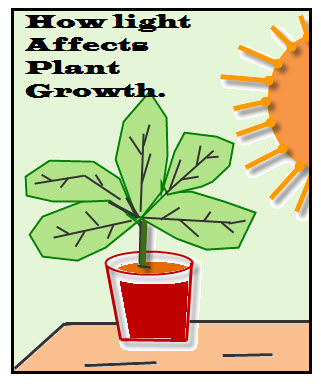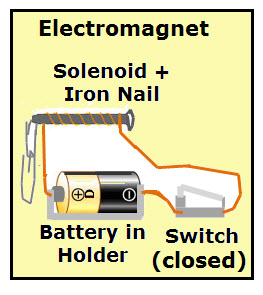Types of Variables in A Science Fair Project
Independent variables
Dependent variables
Controlled variables
Example: Investigate Electromagnetics
An electromagnetic has a metal core (iron rod) with wire wrapped around it. Make an electromagnetic so that you understand how it works.
———————————————————–
Example: Investigate Plant Growth
List what you know about plant growth.

Following are more examples of variables.
A variable is part of an experiment that can change, such as the amount of light, temperature, humidity, or plant growth as well as the direction of plant growth.
In an experiment, an independent variable is a variable that changes either on its own, or you purposely change it. For example, you can control the amount of light, environmental temperature, and humidity in which a plant is grown.
The goal of an experimental investigation is to determine how changes in an independent variable affects another variable, which is called the dependent variable.
Remember: When designing an Experimental Investigation it is important that you only have one independent variable and one dependent variable. All other variables must be controlled, meaning they must stay the same.
FYI: Controlled variables are not the same as a Control for your Investigation. The following will explain this.
Start Experiment Design:
I want you to understand some of the thought processes for designing an experiment that meets Science Fair Project requirements.
1. You need to have a purpose for your investigation. At this point you may not know exactly what you want to do, but let’s assume you want to work with plants. I’d search the web and find different project ideas about plants.
Let’s assume you decide to investigate how light affects plant growth. At this point you need to write a basic purpose. I point out that this might only be a BASIC Purpose, meaning you may need to improve it.
Basic Purpose of Investigation: How light affects plant growth.
I’ll come back to the purpose, but next you need to write your science fair question.
2. The question for an experimental investigation must identify both the independent variable and the dependent variable. Your basic purpose identifies light as the independent variable and plant growth as the dependent variable.
Don’t Forget: The independent variable and the dependent variable for an experimental investigation must be measurable.
Measuring the Independent Variable
How does one measure light?
Light is very general. You need to be more specific about the independent variable. You will get the point after reading the following questions.
- Do you want to measure how different types of light sources, such as sunlight, artificial light, or colored light affects plant growth? This is a good idea for a science project.
- Do you want to measure how changes in the amount of one type of light effects plants growth?
This is another good idea for a science project.
You may have other ideas about the light you want to use, but for this article, I will give examples for measuring the amount of one type of light.
The Independent Variable is the amount of light the plant received.
Ideas for how to change the amount of light.
1. Use sunlight, which changes during the day as well as from one day to the next.
You can also use direct and indirect sunlight.
2. If you use artificial light you can decide when and for how long the plant will receive this light. You also have the option to control the wattage of light used–its color–type (fluorescent, UV, incandescent). Just use the same type of light for each test plant.
Dependent Variable
The purpose of changing an independent variable is to decide how the changes affect something else, which is called the dependent variable. In other words, changes in the independent variable may cause the dependent variable to change.
In an experiment, a dependent variable may change due to the changes made in the independent variable.
For the earlier plant experiment, “How Plants Grow In Response to Light,” the growth of the plant is the dependent variable being observed The plant growth is in response to changes in the amount of light the plant receives, is the independent variable.
Controlled Variables
Controlled variables sounds like an oxymoron. Just remember that variables are things that CAN change. This means that they can be controlled and prevented from changed.
It is important that when you experiment that you have only two variables that change:
- The independent variable that you want to change and can measure how it changes.
- The dependent variable that you are measuring to see how much it changes in response to the independent variable.
Changes in any other variable could affect your results. So, you must try to control any other variable, meaning you want to delete them if possible, or at least make an effort to reduce their influence if possible.
For example, in the previous experiment, “How Plants Grow In Response to Light,” the variables that must be controlled include;
- the type of plant tested,
- container,
- type of soil, temperature,
- amount of water,
- humidity,
- type of light
These variables need to be the same for every plant tested. Some variable are difficult to control, but you should try to make every effort to keep them the same during the testing.
Use the Search on this website to find more examples of variables, one that parallels the information on this page, but provides another example, is The Variables of Testing Onions In a Hay Filled Bathtub.
